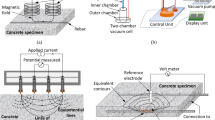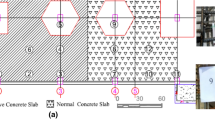Abstract
Performance of concrete structures is significantly influenced and governed by its durability and resistance to environmental or exposure conditions, apart from its physical strength. It can be monitored, evaluated and predicted through modeling of physical deterioration mechanisms, performance characteristics and parameters and condition monitoring of in situ concrete structures. One such study has been conducted using Non-destructive testing equipment in the city of Bhopal and around located in India. Some selected parameters influencing durability of reinforced concrete (RC) structures such as concrete cover, carbonation depth, chloride concentration, half cell potential and compressive strength have been measured, for establishing correlation among various parameters and age of structures. Effects of concrete cover and compressive strength over the variation of chloride content with time are also investigated.
Similar content being viewed by others
References
Ahmed I, Ahmed M Z. Premature deterioration of concrete structures — case study. Journal of Performance of Constructed Facilities, 1996, 10(4): 164–170
Amleh L, Mirza M S. Corrosion response of a decommissioned deteriorated bridge decks. J Per Constr Fac, 2004, 18(4): 185
Rens K L, Wipf T J, Klaiber F W. Review of nondestructive evaluation techniques of civil infrastructure. J Per Constr Fac, 1997, 11(4): 152–160
Song H, Kwon S, Byun K, Park C. Predicting carbonation in earlyaged cracked concrete. Cement and Concrete Research, 2006, 36(5): 379–389
Pal S C, Mukherjee A, Pathak S R. Corrosion behavior of reinforcement in slag concrete. ACI Materials Journal, 2002, 99(6): 1–7
Chai W, Li W, Ba H. Experimental study on predicting service life of concrete in the marine environment. The Open Civil Eng J, 2011, 5: 93–99
Val D V, Chernin L, Stewart M G. Experimental and numerical investigation of corrosion-induced cover cracking in reinforced concrete structures. Journal of Structural Engineering, 2009, 135(4): 376–385
Sangoju B, Gettu R, Bharatkumar B H, Neelamegam M. Chloride induced corrosion of steel in cracked OPC and PPC concretes: Experimental study. Journal of Materials in Civil Engineering, 2011, 23(7): 1057–1066
Pradhan B, Bhattacharjee B. Half cell potential as an indicator of chloride-induced rebar corrosion initiation in RC. Journal of Materials in Civil Engineering, 2009, 21(10): 543–552
Parthiban T, Ravi R, Parthiban G T. Potential monitoring system for corrosion of steel in concrete. Advances in Engineering Software, 2006, 37(6): 375–381
Soylev T A, Fracois R. Corrosion of reinforcement in relation to presence of defects at the interface between steel and concrete. Journal of Materials in Civil Engineering, 2005, 17(4): 447–455
Carino N J. Nondestructive techniques to investigate corrosion status in concrete structures. J Per Constr Fac, 1999, 13(3): 96–106
Sharma S, Mukherje A. Monitoring corrosion in oxide and chloride environments using ultrasonic guided waves. Journal of Materials in Civil Engineering, 2011, 23(2): 207–211
Shah A A, Hirose S. Non linear ultrasonic investigation of concrete damaged under uniaxial compression step loading. Journal of Materials in Civil Engineering, 2010, 22(5): 476–483
Nassr A A, El-Dakhakhni W W. Damage detection of FRPstrengthened concrete structures using capacitance measurements. Journal of Composites for Construction, 2009, 13(6): 486–497
Ervin B L, Kuchama D A, Bernhard J T, Reis H. Monitoring corrosion of rebar embedded in mortar using high frequency guided ultrasonic waves. Journal of Engineering Mechanics, 2009, 135(1): 9–18
Stergiopoulou C, Aggour M S, McCuen R H. Non destructive testing and evaluation of concrete parking garages. J Infra Sys, 2008, 14(4): 319–326
Li G P, Hu F J, Wu Y X. Chloride ion penetration in stressed concrete. Journal of Materials in Civil Engineering, 2011, 23(8): 1145–1153
Tesfamariam S, Martin-Perez B. Bayesian belief network to assess carbonation-induced corrosion in reinforced concrete. Journal of Materials in Civil Engineering, 2008, 20(11): 707–717
Parameswaran L, Kumar R, Sahu G K. Effect of carbonation on concrete bridge service life. J Bid Eng, 2008, 13(1): 75–82
Costa A, Appleton J. Chloride penetration in marine environmentpart II: prediction of long term chloride penetration. Scien Rep RILEM 354–359, 1998
Rens K L, Kim T. Inspection of Quebec street bridge in Denver, Colardo: destructive and nondestru testing. J Per Constr Fac, 2007, 21(3): 215–224
Yehia S, Abudayyeh O, Nabulsi S, Abdelqader I. Detection of common defects in concrete bridge decks using non desctructive evaluation techniques. Journal of Bridge Engineering, 2007, 12(2): 215–225
Durham S A, Heymsfield E, Tencleve K D. Cracking and reinforcement corrosion in short-span precast concrete bridges. J Per Constr Fac, 2007, 21(5): 390–397
Bola M M B, Newtson C M. Field evaluation of marine structures containing calcium nitrite. J Per Constr Fac, 2005, 19(1): 28–35
Pascale G, Leo A D, Bonora V. Nondestructive assessment of the actual compressive strength of high strength concrete. Journal of Materials in Civil Engineering, 2003, 15(5): 452–459
Dias W P S, Jayanandana A D C. Condition assessment of a deteriorated cement works. J Per Constr Fac, 2003, 17(4): 188–195
Sun Y, Chang T, Liang M. Service life prediction for concrete structures by time-depth dependent chloride diffusion coefficient. Journal of Materials in Civil Engineering, 2010, 22(11): 1187–1190
Masada T, Sargand S M, Tarawneh B, Mitchell G F, Gruver D. Inspection and risk assessment of concrete culverts under Ohio’s bridge. Journal of Performance of Constructed Facilities, 2007, 21(3): 225–233
Huang Y, Adams T M, Pincheira J A. Analysis of life cycle maintenance strategies for concrete bridge decks. Journal of Bridge Engineering, 2004, 9(3): 250–258
Marques P F, Costa A. Service life of RC structures: carbonation induced corrosion. perspective vs. performance-based methodologies. Construction & Building Materials, 2010, 24(3): 258–265
Bastidas-Arteaga E, Sánchez-Silva M, Chateauneuf A, Silva M R. Coupled reliability model of biodeterioration, chloride ingress and cracking for reinforced concrete structures. Structural Safety, 2008, 30(2): 110–129
Cheung M M S, Zhao J, Chan Y B. Service life prediction of RC bridge structures exposed to chloride environments. Journal of Bridge Engineering, 2009, 14(3): 164–178
Cao H T, Sirivivatnanon V. Service life modelling of crack-freed and cracked reinforced concrete members subjected to working load. CIB world building congress, April 2001, Wellington, New Zealand, 2001, 1–11
Liang M, Huang R, Feng S, Yeh C. Service life prediction of pier for the existing reinforced concrete bridges in chloride-laden environment. Journal of Marine Science and Technology, 2009, 17(4): 312–319
Klinesmith D E, McCuen R H, Albrecht P. Effect of environmental conditions on corrosion rates. Journal of Materials in Civil Engineering, 2007, 19(2): 121–129
Stewart M G, Val D V. Multiple limit states and expected failure costs for deteriorating reinforced concrete bridge. Journal of Bridge Engineering, 2003, 8(6): 405–415
Sobhani J, Ramezaninpour A A. Modeling the corrosion of reinforced concrete structures based on fuzzy systems. In: Proceedings of the 3rd International Conference of Concrete Development. 27–29 April, Tehran, Iran, 2009, 729–741
Caner A, Yanmaz A M, Yakut A, Avsar O, Yilmaz T. Service life assessment of existing highway bridges with no planned regular inspections. J Per Constr Fac, 2008, 22(2): 108–114
Li C Q, Lawanwisut W, Zheng J J. Time-dependent reliability method to assess the serviceability of corrosion affected concrete structures. Journal of Structural Engineering, 2005, 131(11): 1674–1680
Author information
Authors and Affiliations
Corresponding author
Rights and permissions
About this article
Cite this article
Verma, S.K., Bhadauria, S.S. & Akhtar, S. In-situ condition monitoring of reinforced concrete structures. Front. Struct. Civ. Eng. 10, 420–437 (2016). https://doi.org/10.1007/s11709-016-0336-z
Received:
Accepted:
Published:
Issue Date:
DOI: https://doi.org/10.1007/s11709-016-0336-z




